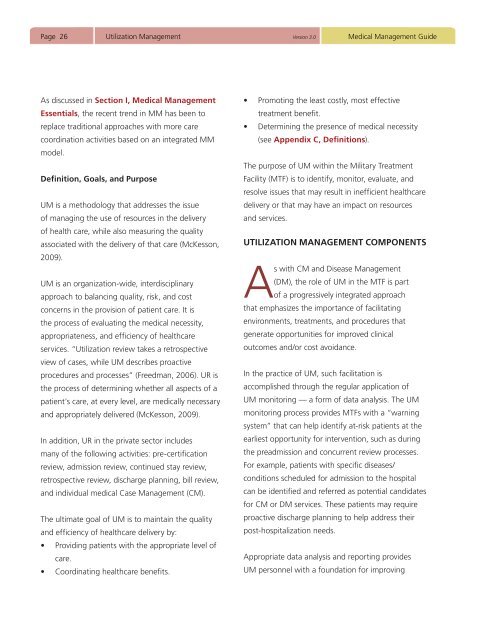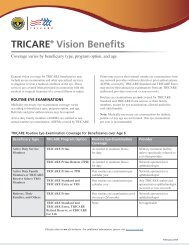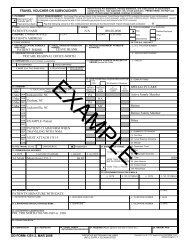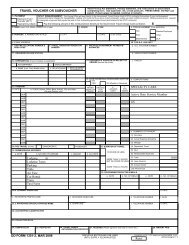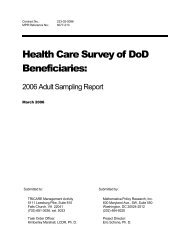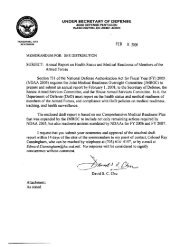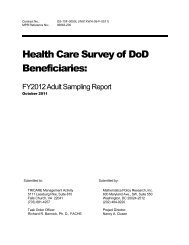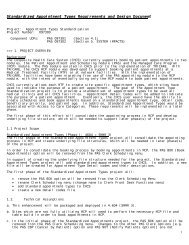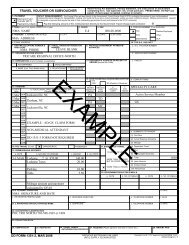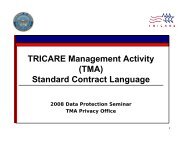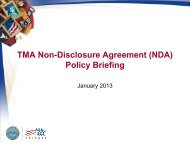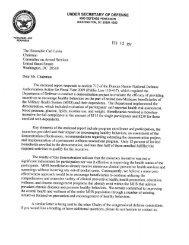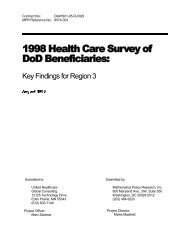Medical Management Guide, 2009, Version 3.0 - Tricare
Medical Management Guide, 2009, Version 3.0 - Tricare
Medical Management Guide, 2009, Version 3.0 - Tricare
- No tags were found...
Create successful ePaper yourself
Turn your PDF publications into a flip-book with our unique Google optimized e-Paper software.
Page 26Utilization <strong>Management</strong> <strong>Version</strong> <strong>3.0</strong><strong>Medical</strong> <strong>Management</strong> <strong>Guide</strong>As discussed in Section I, <strong>Medical</strong> <strong>Management</strong>Essentials, the recent trend in MM has been toreplace traditional approaches with more carecoordination activities based on an integrated MMmodel.Definition, Goals, and PurposeUM is a methodology that addresses the issueof managing the use of resources in the deliveryof health care, while also measuring the qualityassociated with the delivery of that care (McKesson,<strong>2009</strong>).UM is an organization-wide, interdisciplinaryapproach to balancing quality, risk, and costconcerns in the provision of patient care. It isthe process of evaluating the medical necessity,appropriateness, and efficiency of healthcareservices. “Utilization review takes a retrospectiveview of cases, while UM describes proactiveprocedures and processes” (Freedman, 2006). UR isthe process of determining whether all aspects of apatient’s care, at every level, are medically necessaryand appropriately delivered (McKesson, <strong>2009</strong>).In addition, UR in the private sector includesmany of the following activities: pre-certificationreview, admission review, continued stay review,retrospective review, discharge planning, bill review,and individual medical Case <strong>Management</strong> (CM).The ultimate goal of UM is to maintain the qualityand efficiency of healthcare delivery by:• Providing patients with the appropriate level ofcare.• Coordinating healthcare benefits.• Promoting the least costly, most effectivetreatment benefit.• Determining the presence of medical necessity(see Appendix C, Definitions).The purpose of UM within the Military TreatmentFacility (MTF) is to identify, monitor, evaluate, andresolve issues that may result in inefficient healthcaredelivery or that may have an impact on resourcesand services.UTILIZATION MANAGEMENT COMPONENTSAs with CM and Disease <strong>Management</strong>(DM), the role of UM in the MTF is partof a progressively integrated approachthat emphasizes the importance of facilitatingenvironments, treatments, and procedures thatgenerate opportunities for improved clinicaloutcomes and/or cost avoidance.In the practice of UM, such facilitation isaccomplished through the regular application ofUM monitoring — a form of data analysis. The UMmonitoring process provides MTFs with a “warningsystem” that can help identify at-risk patients at theearliest opportunity for intervention, such as duringthe preadmission and concurrent review processes.For example, patients with specific diseases/conditions scheduled for admission to the hospitalcan be identified and referred as potential candidatesfor CM or DM services. These patients may requireproactive discharge planning to help address theirpost-hospitalization needs.Appropriate data analysis and reporting providesUM personnel with a foundation for improving


